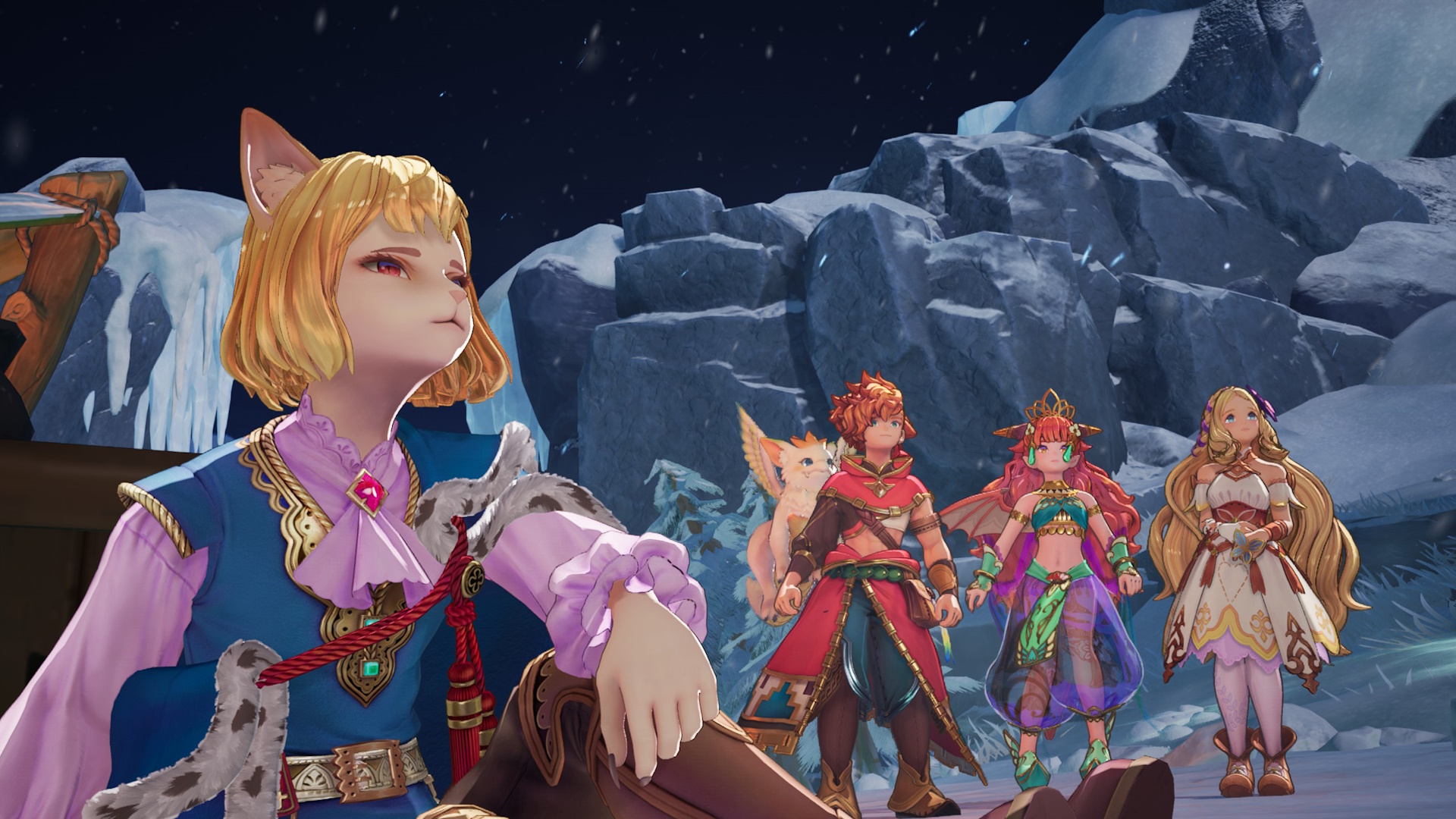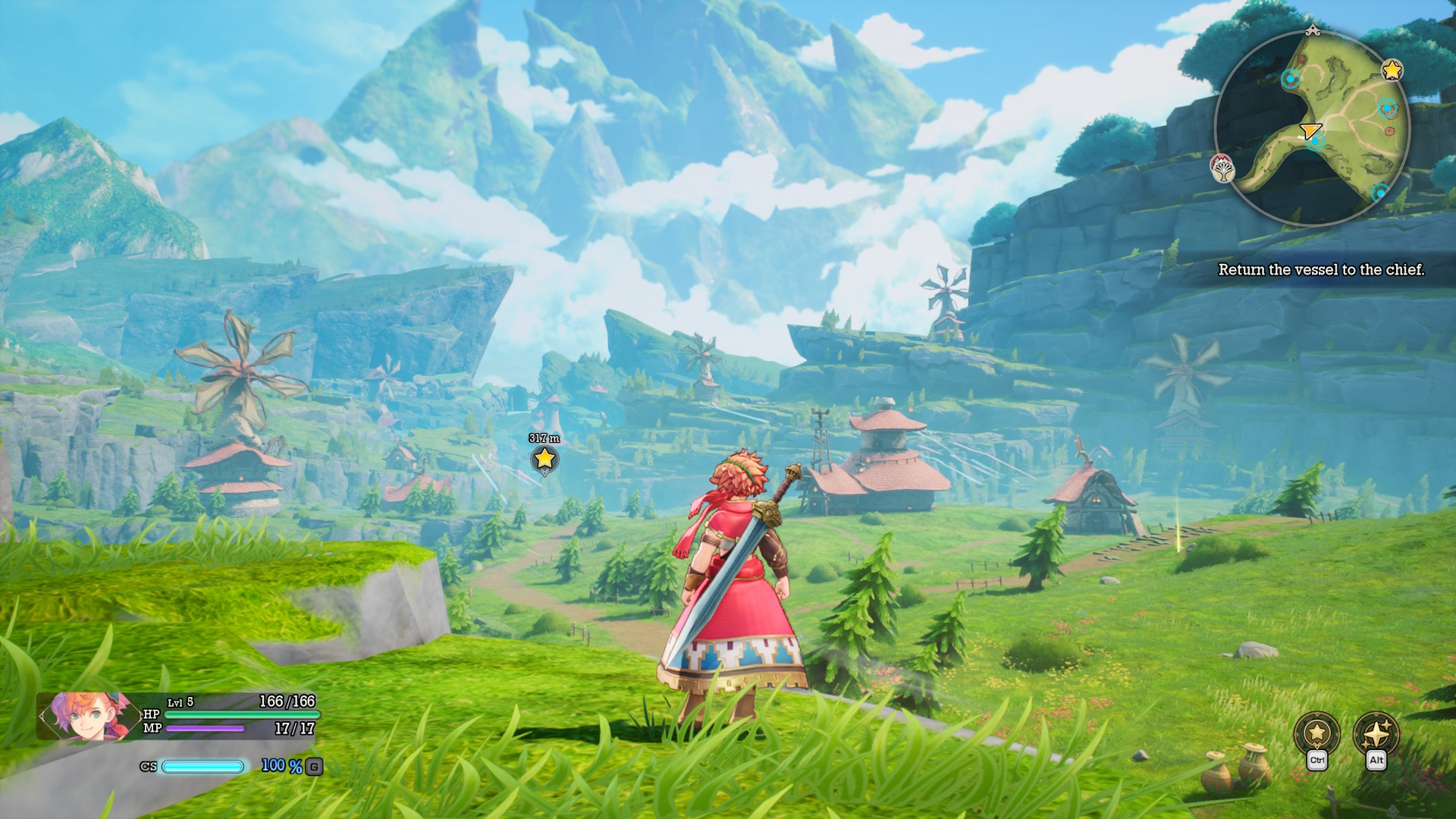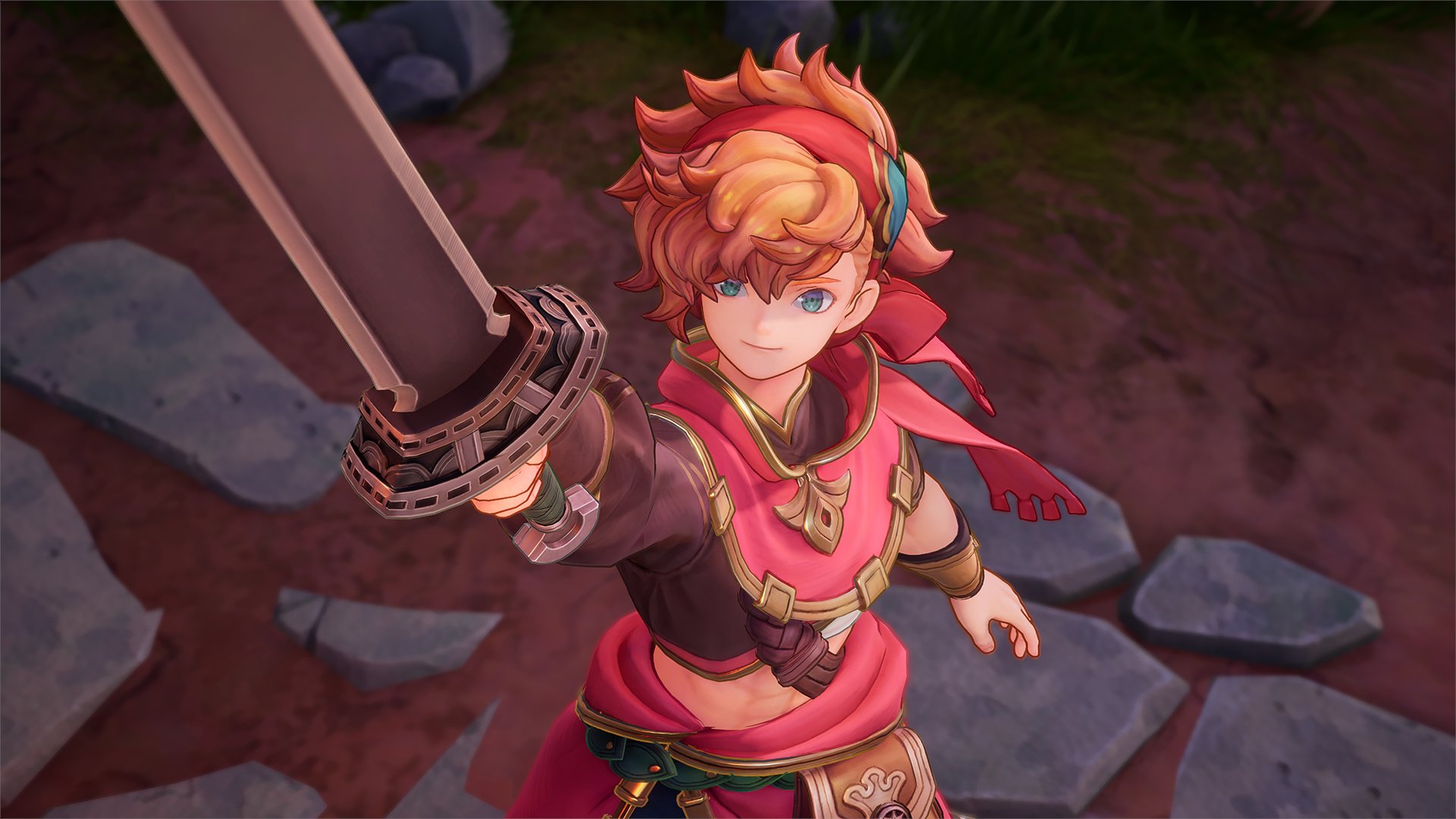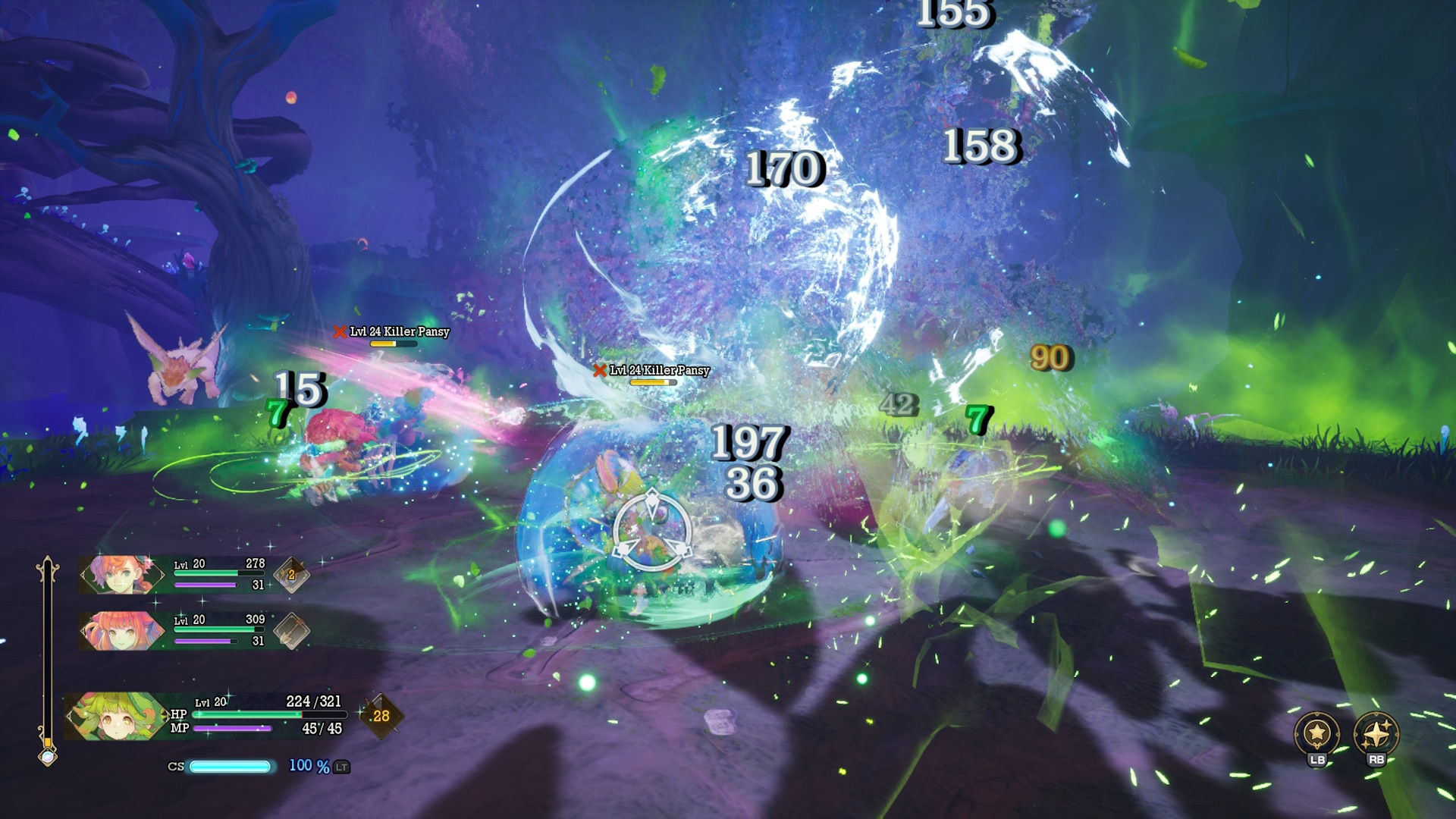
When I've finally gathered one of my last party members in Visions of Mana and set off for the eponymous tree, I make for the great causeway connecting the largest islands of the fantastical archipelago my characters call home. A cutscene triggers, they say their goodbyes to their friends in the capital city full of squirrel people, and then I appear on the other end of a bridge across the sea.
But what a view. A new vista is before me of a land perpetually in harvest. Rolling fields of amber grain and tiny farmhouses dot the land. A waypoint is on the horizon, the next stop en route to the tree. I summon my mount – a large wolf this guy I met a couple of hours ago gave me for some reason – and set out across the land. It takes a few seconds to summon, and to dismount, and the animation stutters whenever I do, so I'm committed to riding all the way over in the minute or two it will take to reach the horizon; that gorgeous view, a beautifully sculpted 3D world that feels so, so empty.
I pass a swarm of hornets armed with spears and monstrous jack-o'-lanterns, but they don't do anything. Perhaps afraid of the dogs, I guess. I could stop. Hold X. Dismount. Basic attack to initiate combat. Only then use combos or magic. But, listen . . . they're like two levels higher than me, which means they'll take about 20 seconds to beat instead of 10, and the experience points wouldn't do anything to really close that gap anyways, so I might as well keep riding until I trigger the next cutscene and repeat all this in the following area.
Prestige looks, freshman worldbuilding

Release date: August 29, 2024
Platform(s): PC, PS5, PS4, Xbox Series X
Developer: Ouka Studios
Publisher: Square Enix
Released in 2006, the last mainline Mana game was developed while I was still in elementary school. Any expectations I had going in were hearsay of the franchise's reputation from its palace on all-time lists, and perhaps much of my disappointment comes from how ARPGs of the past decade have iterated while Visions of Mana's design choices feels stuck on the PS2. But I really gave it a go. I did the side quests, explored each region, but I just kept triggering cutscenes every few yards and only found rudimentary platforming challenges hidden around its world. After 10 hours I gave up on the game actually opening up, on finding any meaningful writing or sense of place.
Visions of Mana is an action RPG with little desire to be unique. What makes it stand out is its series of bewildering design choices and faulty execution that feels as janky as an affectionately remembered PS2 RPG, but with a big budget, prestige presentation and the name of one of the most memorable franchises in RPG history attached to it.
It shockingly begins in a small town as a chosen hero boy, Val, sets out on a quest with his girlfriend, Hinna, to bring together the maidens of each region's elemental magic, who must regularly sacrifice themselves to the spirit tree to maintain the vitality of their world. What nuance there is to its generic story I can't really get into here, but all the subversion is as predictable as you expect it to be at hour one.

The actual experience of playing the early game is a combo of triggering cutscenes every 10 seconds and zooming through areas of different biomes faster than it takes to actually remember any of their names. Each is a gorgeous, empty theme park, more like the requisite sand, water, and grass levels of a Mario or Kirby game rather than a fantasy world people live in. There are NPC side characters in towns and out in the world, but none of them stand out. They only say one-liners directed at no one in particular while their quests are rote fetches for the likes of an ingredient, a lost item, or a nuisance monster.
The supporting and main cast do boast some unique character designs, but each feels reducible to a few sentences of description. My party doesn't really have an arc to follow save for the chosen boy at the middle of it all. And their dialogue, all well acted in what must have been an expensive production, is just empty plot steps.
Outside of Val, the most complicated member of the party is Morley, an angsty cat boy voiced delectably by Kaiji Tang. Val, Hinna, and another Alm find him in the ruins of his home, which met a terrible fate while he was a child. Morley has spent years brooding in the blizzard ravaging the region trying to bring everyone back, and the party helps teach him that he ultimately needs to accept there is no rewinding time. Which is all great but takes less than an hour to watch unfold and from the moment he actually joins your party, his emotional journey is completed.
It's shockingly brief, and certainly out of step with recent peers. Trails Through Daybreak, for example, has a similar structure around recruiting party members, but each of its cast gets at least five hours of a chapter devoted to them joining your team and dozens more hours of characterization afterwards. Visions of Mana zooms through its plot beats and its world too fast to spend any time finding each character's, well, character.
Visions of better games

The action part of the RPG is just as shallow. Each character can change classes to use different elements, which offer different spells and weapons. Most of combat is spent using weapons rather than magic, and while fans, spears, and combat boots do offer variety, the two-button combos get old fast. Elemental super abilities provide some unique interaction — wind keeps monsters in place with a tornado, water surrounds foes in bubbles that deal extra damage, fire rockets you into foes — but that's all they really do. Once you get the controls down and realize each character has a linear upgrade path for each of their elemental classes, Visions of Mana starts to feel surprisingly small in scope.
These systems don't add up to anything, let alone synergize. For all the buttons, slots, and classes I can fuss with, there's nothing that brings them together. Some classes are more tanky, offensive, or supportive, so composition is some consideration, but not a huge one given the (lack of) difficulty. Some element's abilities may also play off each other powerfully, like combining the Moon Elemental's ability to slow down enemies in range, leaving them vulnerable to offensive moves like the Fire Elemental's rocket. But these aren't combos by any means, and there's no depth like in Xenoblade Chronicles 2's chain attack system, which incentivized using different elemental attacks as a way to build up to potentially massive damage if followed up on properly over the course of longer, harder battles.
I quickly found the screen would get too cluttered to see my party or enemies, and with no optional targeting lines or much color coding going on, combat choreography is unintelligible.
But the camera is actually the biggest challenge in Visions of Mana. Targeting is unreliable and the auto camera swings wildly around the action. While it's neat that I can swap between my three active party members in combat, other characters are often off screen so I wouldn't know if I should jump to them. The AI controlling them will use their special abilities, and since there's no bigger play I have to build up to over a battle, there's little point to swap. It also doesn't help that the input just feels unresponsive.
Worst of all, after getting some mid-game spells, I quickly found the screen would get too cluttered to see my party or enemies, and with no optional targeting lines or much color coding going on, combat choreography is unintelligible. While not an easy challenge to design around, we've previously seen Monolith Soft pull it off with upwards of six swappable party members within Xenoblade Chronicles 3 combat (in less than HD resolution, no less).
Visions of Mana disappoints in a thousand other much smaller ways. Its cutscenes lack establishing shots, time passes at confounding intervals between scenes, mounting animations are tedious and you can't dismount right into combat, item menus get stuck open, and one time a character said she needed to get some fresh air while she was standing outside in a desert.
Playing Visions of Mana is like solving a loose Rubik's cube, trying to cut tape with dull scissors, or riding a bike with a few broken spokes. It works, but it's off-kilter in an unintuitive way. It's amazing how many games are able to pull off the illusion of something cohesive and smooth, teetering on the edge of becoming too janky to imitate fiction. It's a shame Visions of Mana isn't one of them.







